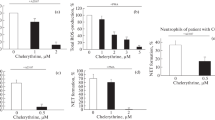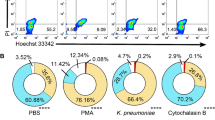Abstract
In vitro studies were conducted to determine the relative importance of various signal transduction factors involved in the phagocytic and oxidative burst activities of cytokine-primed bovine neutrophils. These neutrophil functions were assayed in the presence of known signal transduction pathways inhibitors which included nicotinamide, staurosporine, genistein, pertussis toxin, RO 20-1724 and U-73122.
Neutrophils were isolated (purity >91%, viability >97%) from EDTA-anticoagulated jugular blood from five healthy Holstein-Friesian heifers. Freshly isolated neutrophils (6 ml, 10 x 106 cells/ml) were incubated separately for 1 h at 37 °C with equal volumes of recombinant human cytokines such as tumour necrosis factor-alpha (500 ng/ml), interleukin-l-alpha (1 ng/ml), granulocyte colony-stimulating factor (25 ng/ml), granulocyte-macrophage colony-stimulating factor (10 ng/ml) and interferon-gamma (10 ng/ml). Aliquots (1.8 ml) of various cytokine-treated neutrophils were exposed to each signal transduction pathways inhibitor for 20 min at 37 °C in the dark. Then, percentage phagocytosis and average number of intracellular bacteria per cell were evaluated microscopically using FITC-labelled opsonised bacteria (Escheria coli 0111:134). Unlabelled opsonised bacteria and dichlorofluorescin diacetate were used to evaluate H2O2 production, a measure of oxidative burst, by flow cytometry.
Phagocytic activity and H2O2 production by bovine neutrophils treated with various cytokines were increased by 52.4–86.1% and 31.3–58.2%, respectively.
These functional activities were significantly (p <0.05) reduced after exposure to different inhibitors of signal transduction pathways. The reduction in phagocytic activity of cytokine-primed neutrophils varied greatly depending on the site of action of various inhibitors, with pertussis toxin and U-73122 being the most inhibitory. In comparison, H2O2 production decreased moderately, with pertussis toxin and U-73122 being the most inhibitory and other inhibitors inducing minimal variations. It was concluded that G-inhibitory proteins (pertussis toxin-sensitive) and phospholipase C play a major role, whereas tyrosine kinase plays a minor role in the phagocytic activity and H2O2 production by cytokine-primed bovine neutrophils.
Similar content being viewed by others
References
Amezaga MA, Bazzoni F, Sorio C et al. (1992) Evidence for the involvement of distinct signal transduction pathways in the regulation of constitutive and interferon gamma-dependent gene expression of NADPH oxidase components (gp91-phox, p47-phox, and p22-phox) and high affinity receptor for IgG (Fc gamma R-I) in human polymorphonuclear leukocytes. Blood 79:735–744
Bajaj MS, Kew RR, Webster RO et al. (1992) Priming of human neutrophil functions by tumor necrosis factor; enhancement of superoxide anion generation, degranulation, and chemotaxis to chemoattractants C5a and F-Met-Leu-Phe?. Inflammation 16:241–250
Balazovich KJ, Almeida HI, Boxer LA (1991) Recombinant human G-CSF and GM-CSF prime human neutrophils for superoxide production through different signal transduction mechanisms. J Lab Clin Med 118:576–584
Bass DA, Parce JW, Dechatelet LR et al. (1983) Flow cytometric studies of oxidative product formation by neutrophils: a graded response to membrane stimulation. J Immunol 130:1910–1917
Berkow RL, Wang D, Larrick JW et al. (1987) Enhancement of neutrophil superoxide production by preincubation with recombinant human tumor necrosis factor. J Immunol 139:3783–3791
Bokoch GM (1990) Signal transduction by GTP binding proteins during leukocyte activation: phagocytic cells. Curr Top Membr Transp 35:65–103
Bomalaksi JS, Freundlich B, Steiner S et al. (1988) The role of fatty acid metabolites in the differentiation of the human monocyte-like cell line U937. J Leukoc Biol 44:51–57
Braquet P, Hosford D, Koltz P et al. (1991) Effect of plateletactivating factor on tumor necrosis factor-induced superoxide generation from human neutrophils. Possible involvement of G proteins. Lipids 26:1071–1075
Cairo MS (1991) Cytokines: a new immuotherapy. Clin Perinatol 18:343–359
Carlson GP, Kaneko JJ (1973) Isolation of leukocytes from bovine peripheral blood. Proc Soc Exp Biol Med 142:853–856
Chedid M, Shirakawa F, Naylor P et al. (1989) Signal transduction pathway for IL-1. Involvement of a pertussis toxin-sensitive GTPbinding protein in the activation of adenylate cyclase. J Immunol 142:4301–4306
Corey SJ, Rosoff PM (1989) Granulocyte-macrophage colonystimulating factor primes neutrophils by activating a pertussis toxinsensitive G protein not associated with phosphatidylinositol turnover. J Biol Chem 264:14165–14171
Di Virgilio F, Stendel O, Pittet D et al. (1990) Cytoplasmic calcium in phagocytic activation. Curr Top Membr Transp 35:180–205
Dobson PR, Plested CP, Jones DR et al. (1989) Interleukin-1 induces a peretussis toxin-sensitive increase in diacylglycerol accumulation in mouse thymoma cells. J Mol Endocrinol 2:R5-R8
Fletcher MP, Seligmann BE (1986) PMN heterogeneity: long-term stability of fluorescent membrane potential responses to the chemoattractant N-formyl-methionyl-leucyl-phenylalanine in healthy adults and correlation with respiratory burst activity. Blood 68:611–618
Gallin JI (1984) Human neutrophil heterogeneity exists, but is it meaningful? Blood 63:977–983
Gatlin KE, Mikinny LC (1990) Monovalent ion transport and membrane potential changes during activation in phagocytic leukocytes. Curr Top Membr Transp 35:127–152
Garigho M, Franco A, Cavallo G et al. (1988) Evidence for a GTPbinding protein involved in interferon-gamma transduction signal. J Interferon Res 8:463–472
Gelfand JA, Fauci AS, Green I et al. (1976) A simple method for the determination of complement receptor-bearing mononuclear cells. J Immunol 116:595–599
Gomez-Cambronero J, Huang CK, Bonak VA et al. (1989) Tyrosine phosphorylation in human neutrophil. Biochem Biophys Res Commun 162:1478–1487
Gresham HD, Zheleznyak A, Mormol JS et al. (1990) Studies on the molecular mechanisms of human neutrophil Fc receptor-mediated phagocytosis. Evidence that a distinct pathway for activation of the respiratory burst results in reactive oxygen metabolite-dependent amplification of ingestion. J Biol Chem 265:7819–7826
Guy GR, Chua SP, Wong NS et al. (1991) Interleukin 1 and tumor necrosis factor activate common multiple protein kinases in human fibroblasts. J Biol Chem 266:14343–14352
Hamilton TA, Becton DL, Somers SD et al. (1985) Interferon-gamma modulates protein kinase C activity in murine peritoneal macrophages. J Biol Chem 260:1378–1381
Jain NC (1986) Schalm's veterinary hematology, 4th edn. Lea and Febiger, Philadelphia, pp 20–86
Jain NC (1993) Essentials of veterinary hematology. Lea & Febiger, Philadelphia, pp 222–246
Jain NC, Paape MJ, Berning L et al. (1991) Functional competence and monoclonal antibody reactivity of neutrophils from cows injected with Escherichia coli endotoxin. Comp Haematol Int 1:10–20
Kabbur MB, (1995) Studies of signal transduction pathways involved in phagocytic and oxidative burst activities of bovine neutrophils. Phd Dissertation, University of California, Davis, pp 56–92
Kabbur MB, Jain NC, Zinkl JG et al. (1991) Heterogeneity in phagocytic and nitroblue tetrazolium reductive properties of neutrophils from cows. Am J Vet Res 52:2023–2028
Khwaja A, Carver JE, Linch DC (1992) Interactions of granulocytemacrophage colony-stimulating factor (CSF), granulocyte CSF, and tumor necrosis factor alpha in the priming of the neutrophil respiratory burst. Blood 79:745–753
Krause PJ, Maderazo EG, Bannon P et al. (1988) Neutrophil heterogeneity in patients with blunt trauma. J Lab Clin Med 112:208–215
Lambeth JD (1988) Activation of the respiratory burst oxidase in neutrophils: on the role of membrane-derived second messengers, Ca+−, and protein kinasse C. J Bioenerg Biomembr 20:709–733
Laudanna C, Rossi F, Berton G (1993) Effect of inhibitors of distinct signalling pathways on neutrophil Q2-generation in response to tumor necrosis factor-alpha, and antibodies against CD18 and CD11a: evidence for a common and unique pattern of sensitivity to wortmannin and protein tyrosine kinase inhibitors. Biochem Biophys Res Commun 190:935–940
Li SH, Chan SC, Toshitani A et al. (1992) Synergistic effects of interleukin 4 and interferon-gamma on monocyte phosphodiesterase activity. J Invest Dermatol 99:65–70
Mayer T, Regenass U, Fabbro D et al. (1989) A derivative of staurosporine (CGP 41251) shows selectivity for protein kinase C inhibition and in vitro anti-proliferative as well as in vivo anti-tumor activity. Int J Cancer 43:851–856
McPhail LC, Harvath L (1993) Signal transduction in neutrophil oxidative metabolism and chemotaxis. In: Abramson JS, Wheeler JG (eds) The neutrophil. IRL Press, New York, pp 63–107
Mizal SB (1990) How does interleukin 1 activate cells? Cyclic AMP and interleukin 1 signal transduction [see comments]. Immunol Today 11:390–391
Moss J, Vaughan M (1988) ADP-ribosylation of guanyl nucleotidebinding regulatory proteins by bacterial toxins. Adv Enzymol Relat Areas Mol Biol 66:303–379
Naccache PH, Gilbert C, Caon AC et al. (1990) Selective inhibition of human neutrophil functional responsiveness by erbstatin, an inhibitor of tyrosine protein kinase. Blood 76:2098–2104
Nielson CP, Vestal RE, Sturm RJ et al. (1990) Effects of selective phosphodiesterase inhibitors on the polymorphonuclear leukocyte respiratory burst. J Allergy Clin Immunol 86:801–808
O'Neill LA, Bird TA, Saklatvala J (1990) How does interleukin 1 activate cells? Interleukin 1 signal transduction. [see comments]. Immunol Today 11:392–394
Paape MJ, Pearson RE, Schultze WD (1978) Variation among cows in the ability of milk to support phagocytosis and in the ability of polymorphonuclear leukocytes to phagocytose Staphylococcus aureus. Am J Vet Res 39:1907–1910
Polakis PG, Evans T, Snyderman R (1989) Multiple chromatographic forms of the formylpeptide chemoattractant receptor and their relationship to GTP-binding proteins. Biochem Biophys Res Commun 161:276–283
Ponzoni M, Cornaglia-Ferraris P (1993) Interferon-gammastimulated and GTP-binding-proteins-mediated phospholipase A2 activation in human neuroblasts. Biochem J 294:893–898
Rapoport AP, Abboud CN, DiPersio JF (1992) Granulocytemacrophage colony-stimulating factor (GM-CSF) and granulocyte colony-stimulating factor (G-CSF): receptor biology, signal transduction, and neutrophil activation. Blood Rev 6:43–57
Reibman J, Haines K, Weissmann G (1990) Alteration in cyclic nucleotides and the activation of neutrophils. Carr Top Membr Transp 35:399–424
Saad AM, Hageltorn M (1985) Flow cytometric characterization of bovine blood neutrophil phagocytosis of fluorescent bacteria and zymosan particles. Acta Vet Scand 26:289–307
Sample AK, Czuprynski CJ (1991) Priming and stimulation of bovine neutrophils by recombinant human interleukin-1 alpha and tumor necrosis factor alpha. J Leukoc Biol 49:107–115
Schutz-Mundling M, Ullrich V (1992) Priming of human polymorphonuclear leukocytes with granulocyte-macrophage colony-stimulating factor involves protein kinase C rather than enhanced calcium mobilization. Eur J Biochem 204:705–712
Schultz RM (1991) Effect of recombinant human granulocyte/ macrophage colony-stimulating factor on neutrophil superoxide production. Immunopharmacol Immunotoxicol 13:183–198
Schutze S, Berkovic D, Tomsing O et al. (1991) Tumor necrosis factor induces rapid production of 1′2′diacylglycerol by a phosphatidylcholine-specific phospholipase C. J Exp Med 174:975–988
Semnani MJ, Kabbur MB, Jain NC (1993) Activation of bovine neutrophil functions by interferon-gamma, tumor necrosis factoralpha, and interleukin-1 alpha. Comp Haematol Int 3:81–88
Silva ID, Jain NC (1988) Phagocytic and nitroblue tetrazolium reductive properties of bovine neutrophils for mammary pathogens. J Dairy Sci 71:1625–1631
Smith RJ, Sam LM, Justen JM et al. (1990) Receptor-coupled signal transduction in human polymorphonuclear neutrophils: effects of a novel inhibitor of phospholipase C-dependent processes on cell responsiveness. J Pharmacol Exp Ther 253:688–697
Steinbeck MJ, Roth JA (1989) Neutrophil activation by recombinant cytokines. Rev Infect Dis 11:549–568
Tanimura M, Kobuchi H, Utsumi T et al. (1992) Neutrophil priming by granulocyte colony stimulating factor and its modulation by protein kinase inhibitors. Biochem Pharmacol 44:1045–1052
Tauber AI, Karnad AB, Ginis I (1990) The role of phosphorylation in phagocytic activation. Curr Top Membr Transp 35:469–495
Thelen M, Dewald B, Baggiolini M (1993) Neutrophil signal transduction and activation of the respiratory burst. Physiol Rev 73:797–821
Thompson WJ (1991) Cyclic nucleotide phosphodiesterases: pharmacology, biochemistry and function. Pharmacol Ther 51:13–33
Traynor-Kaplan AE (1990) Phosphoinositide metabolism during phagocytic cell activation. Curr Top Membr Transp 35:303–362
Utsumi T, Klostergaard J, Akimaru K et al. (1992a) Modulation of TNF-alpha-priming and stimulation-dependent superoxide generation in human neutrophils by protein kinase inhibitors. Arch Biochem Biophys 294:271–278
Utsumi T, Klostergaard J, Akimaru K et al. (1992b) Effect of tumor necrosis factor-alpha on the stimulus-coupled responses of neutrophils and their modulation by various inhibitors. Physiol Chem Phys Med NMR 24:77–88
Valinoti JM, Zinkl JG, Jain NC (1989) Combined phagocytosisnitroblue tetrazolium reduction test in bovine neutrophils. Vet Clin Pathol 17:99–104
Watson ED (1989) In vitro function of bovine neutrophils against Actinomyces pyogenes. Am J Vet Res 50:455–458
Williams MR, Bunch KJ (1981) Variation among cows in the ability of their blood polymorphonuclear leucocytes to kill Escherichia coli and Staphylococcus aureus. Res Vet Sci 30:298–302
Yaish P, Gazit A, Gilon C et al. (1988) Blocking of EGF dependent cell proliferation by egf receptor kinase inhibitors. Science 242:933–935
Author information
Authors and Affiliations
Rights and permissions
About this article
Cite this article
Kabbur, M.B., Jain, N.C. Signal transduction pathways involved in phagocytic and oxidative burst activities of cytokine-treated bovine neutrophils. Comparative Haematology International 5, 38–46 (1995). https://doi.org/10.1007/BF00214489
Issue Date:
DOI: https://doi.org/10.1007/BF00214489




